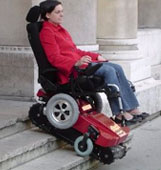|
|

|
Stairclimbing Wheelchairs
In a world of urban and home designs that are woefully unsuited for people with mobility impediments, especially those confined to wheelchairs, a technology capable of overcoming the most commonplace obstacles, like stair climbing wheelchairs, can truly change the level of independence and interaction the person can have in the world.
Stairclimbing wheelchairs are extremely flexible pieces of equipment in that they can double as regular wheelchairs and negotiate stairs and terrain obstacles.
How Stairclimbing Wheelchairs Function
Stairclimbing wheelchairs use computerized parts, gyroscopes, cameras and other types of machinery to detect obstacles like steps or curves, shifting its shape to overcome them by sending a set of wheels upwards and lifting itself. Another kind does keep all four wheels on the floor without uplifting, and uses weight balancing to move over the obstacles. The user then weight shifts to control climbing speeds, stopping points and direction. Of course, for safe use, the owner must understand the system’s limitations and the amount of forethought its movements require.
Stairclimbing Wheelchair Requisites
Unfortunately, the technology in stair climbing wheelchairs does require a certain physical condition from the users. To operate it and use the weight-shifting directions, the wheelchair bound person must have use of at least one arm and upper body muscle tone. Also, weight in excess of 200 pounds renders the gyroscope calibrations unreliable, so the prospect user would be advised to, under the care of a medic or occupational therapist, shed overweight and build the necessary muscle tonicity.
Stair climbing wheelchair are custom calibrated to respond to its unique user’s inputs, so it’s not an equipment to be shared easily in a facility, and it should definitely never be borrowed for try-outs.
Stairclimbing wheelchair Pricing:
It comes with no surprise that the true downside to this technology is its pricing structure. The technology involved in these stairclimbing systems can raise them to a price tag of twenty-two thousand dollars in the case of the now retired iBot, by Johnson & Johnson. According to costumer reviews, these chairs are groundbreaking in the independence they allow for, but Medicare considers them unnecessary for home use, and therefore only participates in the six thousand dollars of a basic wheelchair. These two factors make acquiring one a heavy economical undertaking, and payment plans or second hand purchases can help offset costs – in fact second hand purchases are the only way to currently acquire the iBot, which was discontinued precisely due to a low sales volume.
However, these high costs weight against the increase in lifestyle quality for the disabled person and in the fact that they overcome household obstacles without the need for equally costly renovations and permanent lifting mountings. To many studies, this lack of investment in a life altering technology that can give wheelchair bound people the ability to visit friends, family and locations they previously found inaccessible, and even perform tasks with more ease and dignity, is symptomatic of a society that hasn’t quite understood all the challenge levels mobility difficulties can bring.
↑ Top
|
|